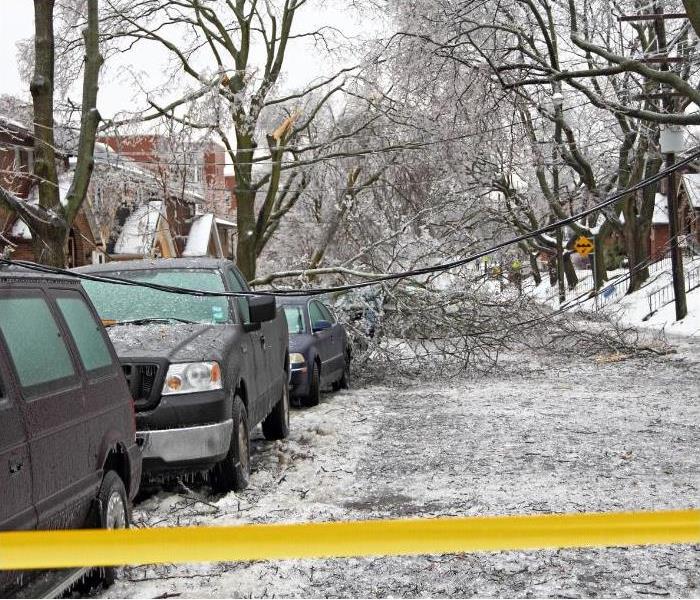9 Winter Prep Tips for Homeowners in Southern States | SERVPRO® of Montgomery
12/1/2021 (Permalink)
 Should you need fire damage, water damage, duct cleaning or reconstruction from ice storms, contact SERVPRO of Montgomery.
Should you need fire damage, water damage, duct cleaning or reconstruction from ice storms, contact SERVPRO of Montgomery.
Winter in Montgomery is fast approaching and you should make sure your home is prepared for much cooler temperatures. There are many things you need to do to keep your home warm and dry during the coming cold months, including sealing gaps in exterior walls and installing insulation in your basement, attic, and crawl space, if applicable. The following tips will help you prepare your southern home for winter 2021 in an efficient way that does not cost a lot of money or take up a lot of your time.
Weather-Stripping
You should check the exterior doors of your home for cold air leaks. Check this from inside of the house. The low-tech approach is to move a burning candle on the doorframes and see if the flames lean towards you when there is a draft. The high-tech way is to use an infrared laser heat gun to detect cold air currents. Seal a drafty door by installing weather-stripping or installing foam inside the doorframe.
There are a lot of weather stripping products that you can purchase to seal those drafts including reinforced felt, metal v-channels, and strips. These materials are self-adhered or nailed along the door inside edges to produce a wind-proof and tight seal. You can ask your hardware store for installation instructions and the appropriate product. You should also do the same on the windows.
Attic Air Leaks
Look and seal gaps that allow as much as 30 percent of your heated air to leak outdoors. Moreover, seal the cutouts in the drywall for pipes, electrical fixtures, outlets, and fans. Besides that, you should check ducts, vent stacks, flues, chimneys, wiring and seal them on the inside. Use pressurized expanding foam for larger openings and caulk to fill smaller gaps.
Water Damage Prevention
It is important to check the drainage system around the foundation of your home. If some soil has settled into a lower spot where the water might pool, just fill it with some more soil to avoid rain freezing, gathering, and thawing in the area during the winter season, which might damage the foundation. You can also use inexpensive pipe sleeves to insulate both cold and hot water pipes that are running through unheated parts of the house. This will assist to keep the temperature of the water regulated which prevents the pipes from freezing.
Carbon Monoxide and Smoke Detectors
This is to make sure that they are functioning well. There is an increased risk of carbon monoxide leaks and fires with heaters on during the winter season due to various heating methods used and warming the car in the garage. Checking smoke detectors to see if they are functioning properly will help prevent massive fire damage, should a small home fire occur.
Refuge for Rodents
Even rodents are inclined towards icy weather as humans. The moment the weather turns chilly, house owners are horrified to hear strange sounds of little paws in the house. There are numerous methods to keep rodents from taking up residence in your home. One of the best approaches to keep them off is starting in the fall, combing the interior and exterior of the house, and eliminating the spaces around them with rodent-proof spray foam, caulk, close-fitting wire mesh, or steel wool.
Programmable Thermostats
According to Energy Star, a programmable thermostat can save you a lot of money in a year on fuel costs. A thermostat will automatically raise or lower your house temperature when you are away while keeping the temperatures consistent.
Furnace Ducts
Ideally, Heating ducts waste 20 to 30 percent of the heated air they carry, losing it to poor conduction and leaks. A leaky heating duct makes it hard to keep your house warm and means higher utility bills. Focus on the areas where ducts, registers, and vents meet floors, ceilings, and walls. Use metal tape or mastic sealant which are long-lasting than duct tape, to seal connections and seams.
Tree Trimming
Check out the trees around your house and ensure no branches are touching the power lines surrounding it or your home. Brittle branches can harm your gutters and siding during stormy winter months. Also, branches on power lines may knock out much-needed power during a winter ice storm.
Hot Water Temperature
Normally, hot water heaters are set at 140 degrees. You can lower the temperature up to 120 degrees to save fuel. This will help to reduce any accidental burns and the water temperature will still be sufficient for doing dishes, washing clothes, and bathing.
If you follow these tips, you will be ready for winter in the south. These tips will help you save money, reduce your energy consumption, prevent damage to your home and give you peace of mind while you comfortably enjoy your winter season.
Should you need fire damage, water damage, duct cleaning or reconstruction from ice storms, contact SERVPRO of Montgomery. We have technicians standing by 24/7 to help.






 24/7 Emergency Service
24/7 Emergency Service